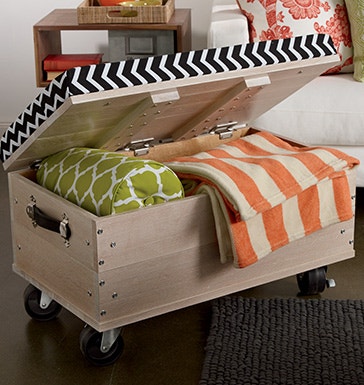Lid Support/Lid Stay Buying Guide
A lid stay is often one of those things that you realize you need once your project is almost done. Don't let it be an afterthought, though.
Lid stays can have a huge impact on the final look, feel and function of your project. Whether for chest lids, drop fronts or overhead doors, they can lend a pleasing tactile feel and practical functionality that no other hardware can provide. In this guide, we'll walk you through all the different types so you can make the right selection to fit your needs.
3 Basic Applications: Chest Lids, Drop-Front Desks and Upward-Opening Doors
The terms "lid stay" and "lid support" can be confusing because the same hardware is often used for applications other than lids. In addition, lid stays can range from something as simple as a thin chain attached with two screws, to something as elaborate as a gas piston that assists in lifting or slows down the travel. To clear up any confusion, let's start by outlining the three primary applications of a lid stay/lid support:
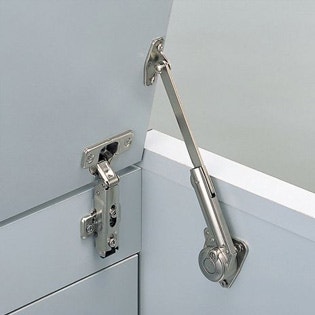
- Chest Lids: Lid stays are commonly used on chest lids as a stop to keep the lid from falling suddenly backwards when opened. It protects the chest, the hinges, the lid and the wall behind the lid from unnecessary impact and strain. Some stays will also lock the lid vertically in the open position until you release it in some way to make it close. An optional feature for chest lid stays, and an essential feature if kids are in the house, is soft-down closure, which eases the lid gently and quietly closed.
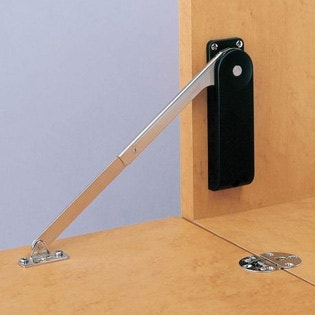
- Drop-Front Desks: For fall-front, drop-front or drop-leaf desks and secretaries, lid stays act as support arms that hold the desk flap in the horizontal position. Often called a "drop front support," this type of stay is built sturdily enough to hold a laptop, and to withstand the user leaning on it with their elbows while writing. If desired, these can be purchased with lift-assist or soft-down features. They are also available as "dual-action" stays, which provide both lift-assist and soft-down.
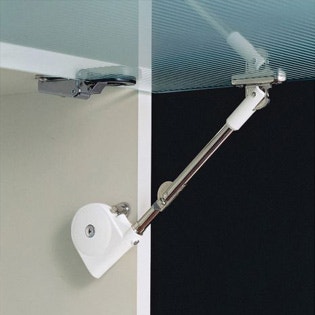
- Upward-Opening Doors: Any upward-swinging door above eye level should have a lid stay that helps open the door (if necessary) and keeps it in the position you open it to. Without a stay, these overhead doors would require one hand to hold them open while you search for items, and would slam shut when released. With a proper stay installed, you can even leave the doors completely open while you work, whether in the kitchen or in the shop, without them getting in the way or you banging your head on them.
Click Here to Shop by Lid Stay Application.
 |
Lid Stay TipBe sure to consider the height of your upward-opening doors when choosing a stay. If the door is mounted high overhead, and could lift itself out of reach, you'll need to choose a stay that maintains the position that you open the door to. Otherwise, you'd need a stool in order to close the door. |
3 Basic Design Types: Folding Stays, Sliding Stays and Piston Stays
Lid stays can be designed and built in many different ways, but they generally boil down to three basic types: folding, sliding and piston. Within each type are numerous different design details, some featuring springs or pneumatic devices to aid in lifting or closing. Read on for more info on the pros and cons of the three basic types.
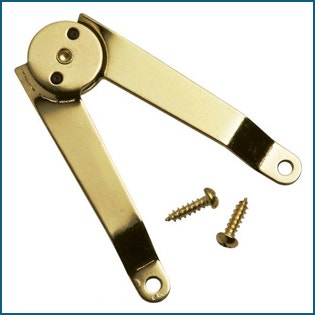
- Folding Stay: These stays consist of two sections hinged in the middle, much like your upper and lower arm, with the elbow acting as the hinge. When the stay is extended, the "elbow" locks, keeping the lid in the open position. Some stays of this type extend slightly further for more secure locking, and require a gentle nudge from behind to unlock. Traditional types are made of solid brass or brass-plated metal, and can lend a beautiful look, but have no effect outside of holding the lid in the open position. More modern designs can be somewhat mechanical in appearance, but can also offer lift-assist and soft-down features, either with a spring or a pneumatic device. In general, folding stays tend to take up less space inside the chest or cabinet. Since they fold, however, they can present a pinch hazard.

- Sliding Stay: Also sometimes called a ''friction stay,'' this type consists of a single arm, often slotted, that slides through the opposite member, which houses some type of high-friction device, often a simple screw that can be adjusted to provide more or less friction. Tightening the screw will result in a stay that holds the lid in whatever position you leave it. Loosening the screw slightly can result in a stay with some degree of soft-down action. Periodic adjustment is often needed with friction stays, and care should be taken to ensure that the long arm of a friction stay has enough clearance inside the box throughout its entire range of motion.

- Piston Stay: These are typically gas springs/pistons that provide either lift-assist, soft-down or both. Due to their bulkier appearance, they are generally used on larger cabinets with heavier lids or overhead doors. They provide a great deal of lifting capacity and durability.
Click Here to Shop by Lid Stay Type.
 |
Lid Stay TipRemember that many lid stays are available in left-hand, right-hand or center-mount models. If this is the case, you can purchase one, two or all three in order to provide the support you need for your lid. |
What if I Need Lift Assist or Soft-Down Features?
If you need lifting action to assist in opening overhead doors, or soft-down action to prevent a chest lid from slamming shut, you'll need to purchase lid supports matched specifically to the size and weight of your door or lid. Since stays can vary so much in their installation and application, it's best to check the manual for each individual stay, which is included in the Technical Documents section of each of our offers. However, below are some general guidelines on the info you will need.
- Inch-Pounds: Many stays are rated to support a certain number of "inch-pounds." Heavier and deeper lids will require more lifting and holding power. To calculate inch/pounds for your chest lid, measure it from front to back. For an upward-opening door, this measurement will be the height of the closed door. Then weigh the door or lid, including any hardware or cushions that will be permanently installed. Plug these two numbers into the following formula, (Lid Depth x Lid Weight in Pounds) ÷ 2, to calculate inch-pounds and make your selection.
- Compatibility Tables: Some stays include a table or compatibility chart in the manual, specifications section, or as an image in the offer. No formula is required in this case, but you will still need the weight and dimensions of your lid/door to find the matching stay on the chart.
- Torsion Calculator: We also offer a handy tool that we call our "Torsion Calculator" for calculating inch-pounds. Just plug in the numbers and it will quickly generate the number of inch-pounds required for your lid. Note that this calculator is designed for our Torsion Hinges, but it's the same inch-pounds formula mentioned above, and is used for numerous brands and types of stays.
Torsion Calculator
Please enter your measurements below

Combination Hinge/Lid Supports: Superb Value and Easy Installation

Keep in mind that most lid stays do not include hinges. One major exception are the Rockler Torsion Hinges just mentioned above. These combine a sleek-looking hinge with a torsion mechanism that holds the lid in whatever position you leave it—just like a laptop hinge. Torsion Hinges represent an excellent value because they bundle the cost of both hinges and lid stays into one attractive product that takes up almost no space inside the cabinet. Add on the time saved with convenient, intuitive surface-mount installation, and it's easy to see why Torsion Hinges have become one of Rockler's most-loved hardware items. Plus, with just one click, the Torsion Calculator tells you exactly which hinges to order.
 |
Lid Stay TipRemember that stop hinges can be an option for small items like jewelry boxes. Since there is little risk if the lid slams shut, a simple hinge like a 90° stop hinge or quadrant hinge can often do the job. |
We hope these tips will give you the support you need when selecting your lid stay! Don't forget that we have expert staff in our stores, online and available by phone to help out if you have a question that's not answered here.
Click here to shop all Lid Stays and Lid Supports
Keep the inspiration coming!
Subscribe to our newsletter for more woodworking tips and tricks
